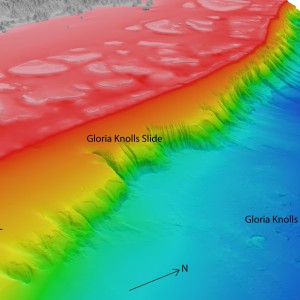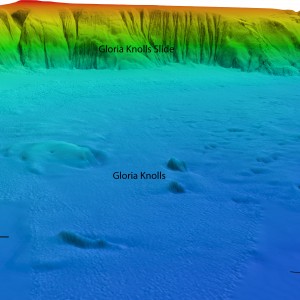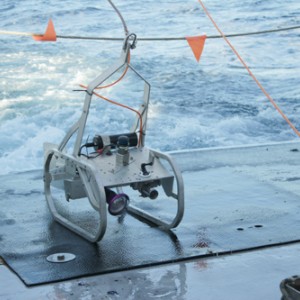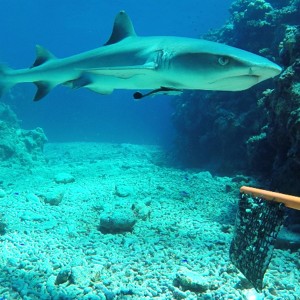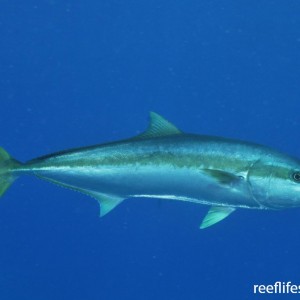AMPS Atlas
This is a compilation of all the images in this Atlas. To access images from particular marine parks, navigate to the image gallery on each marine park page.

A view of the abyssal seafloor off eastern Australia taken by a camera towed from the RV Investigator.
A north-westerly view of the Gloria Knolls slide off Innisfail. Depths are coloured red (shallow) to blue (deep), over a depth range of about 1700 metres.
The Gloria Knolls landslide - a westerly view of the Gloria Knolls lying in the Queensland Trough downslope of the Gloria Knolls Slide. Depths are coloured red (shallow) to blue (deep), over a depth range of about 1500 metres.
This image of the mumbararr whipray was taken during a 2015 trial assessment in PNG for the Turtle excluder Device (TED) and Bycatch Reduction Device (BRD).
 by PNG National Fisheries Authority
by PNG National Fisheries AuthorityA tiger shark, easily recognisable by the dark stripes along its sides, is attracted to the camera by a baited steel arm on a BRUV system. This BRUV was deployed by researchers at the Australian Institute of Marine Science and Global Finprint program in an effort to monitor the impact of the crack-down on illegal fishing on the shark population at Ashmore Reef.
A typical AUV image showing mid-shelf reef ledges within the Flinders Marine Park (depth 60 metres). This image indicates the sedimentary rock type that appears to form the majority of the reef habitat in the cross shelf region of this part of the coastal zone. Of particular note is the clear iron-rich nature of this particular outcrop. Also of note is that such overhanging reef-ledges are a typical characteristic of the shallow dipping sedimentary rock type in this area, reflecting bedding planes between the sedimentary layers. While they are a characteristic feature, such "ledges" only represent a very small fraction of the overall mapped "reef" habitat yet are likely to be most important for many of the fish species and lobsters that need the ledges as habitat. The remaining reef area appears to be very flat low-profile reef with little refuge space available.
 by IMOS, Institute of Marine and Antarctic Studies
by IMOS, Institute of Marine and Antarctic StudiesReef Life Survey volunteer diver conducting underwater visual census survey of marine life, Lord Howe Island Marine Park, New South Wales. The Reef Life Survey program is a volunteer network of highly trained divers, and is a product of the CERF Major Projects funding that facilitated a cost-effective citizen science contribution to inventory and monitoring of shallow water marine environments. The RLS program has been further facilitated within the NERP Hub, describing biodiversity patterns at a national and global scale, as well as providing critical baseline data from areas such as the new Coral Sea Marine Park, from Ashmore Reef, the Great Barrier Reef,and other Australian Marine Parks such as the Cod Grounds.
 by Reef Life Survey
by Reef Life SurveyThis killer whale is known at Tarni (WA089). Tarni has been catalogued since 2014 by Project ORCA, a research initiative that investigates the distribution, abundance, bioacoustics and population dynamics of killer whales in Australian waters. The Bremer Marine Park is a known hotspot for this species, and one of the primary study sites for Project ORCA. Tarni, easily recognisable by the nick in the tip of the dorsal fin and and "X" scarring on the saddle patch, was named after the Australian Indigenous word meaning "surf or wave" in the Kaurna language. An appropriate name as Tarni is regularly seen surfing the wake of our research vessel or charging through the big swell in the Bremer region.
This whale shark was photographed in the Ningaloo Marine Park off Western Australia. Whale sharks are the worlds biggest fish. The name whale shark arose because they are as big as a whale (recorded up to 18 metres) and also filter feed much like many whales. However, whale sharks breath via gills, and have cartilage instead of bone, which makes them a true shark. The Ningaloo Marine Park is a well known for the whale sharks that visit the region from the months of March to July each year. There is still a lot to learn about whalesharks and where they go when they are not at Ningaloo.
 by Wayne Osborne
by Wayne OsborneA seascape impacted by bottom-trawling where only relatively small, flexible and more resilient corals remain (1118 metres depth). Slow coral growth rates means recovery of these ecosystems is expected to be protracted; little change was observed over a decade during a CSIRO study.
 by CSIRO
by CSIROWhite seawhip (Junceella fragilis) with schooling fish on a reef in Arnhem Marine Park.
 by Reef Life Survey
by Reef Life SurveyA white-tip reef shark at Scott Reef, attracted to the camera by a baited steel arm on a BRUV system.
Wildlife and oceanographic surveys of the Bremer Marine Park. The Bremer Marine Park was sampled as part of a collaborative government funded program designed to provide critical baseline information on the presence of marine megafauna in the region and the potential physical factors affecting their distribution. Multiple sampling platforms were used, including visual transects conducted from the air (black), drifting underwater camera traps (known as stereo-BRUVS, dark blue), passive acoustic recordings (orange) and water profiles obtained from an autonomous deep-diving Seaglider (yellow). Large sharks (1), cetaceans (2) and molluscs (3) were among the species encountered within and outside the park boundaries.
A coral reef community in Coral Sea Marine Park. Still image taken as part of underwater visual census of marine life for the Reef Life Survey program. The Reef Life Survey program is a volunteer network of highly trained divers, and is a product of the CERF Major Projects funding that facilitated a cost-effective citizen science contribution to inventory and monitoring of shallow water marine environments. The RLS program has been further facilitated within the NERP Hub, describing biodiversity patterns at a national and global scale, as well as providing critical baseline data from areas such as the Coral Sea Marine Park, from Ashmore Reef, the Great Barrier Reef, and other Australian Marine Parks such as the Cod Grounds.
 by Reef Life Survey
by Reef Life SurveyA Yellowtail Kingfish, Seriola lalandi, a target species found in Cod Grounds Marine Park favoured by commercial and recreational fishers.

